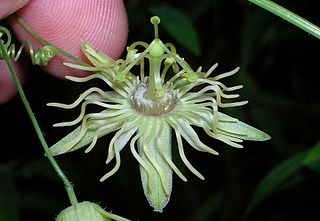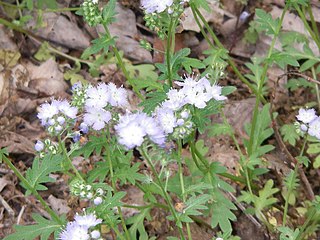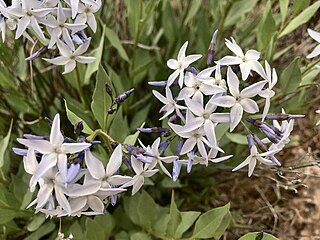
Trifolium stoloniferum, the running buffalo clover, is an endangered species of perennial clover native to the eastern and midwestern United States. From 1940 to 1985 it was believed to be extinct until two populations were discovered in West Virginia. Since then, more populations have been found in the US but it still remains one of the most imperiled plants in North America.

Sabal minor, commonly known as the dwarf palmetto, is a small species of palm. It is native to the deep southeastern and south-central United States and northeastern Mexico. It is naturally found in a diversity of habitats, including maritime forests, swamps, floodplains, and occasionally on drier sites. It is often found growing in calcareous marl soil. Sabal minor is one of the most frost and cold tolerant among North American palms.

Yucca filamentosa, Adam's needle and thread, is a species of flowering plant in the family Asparagaceae native to the southeastern United States. Growing to 3 metres tall, it is an evergreen shrub valued in horticulture.

Ageratina altissima, also known as white snakeroot, richweed, or white sanicle, is a poisonous perennial herb in the family Asteraceae, native to eastern and central North America. An older binomial name for this species is Eupatorium rugosum, but the genus Eupatorium has undergone taxonomic revision by botanists, and some species once included in it have been moved to other genera.

Passiflora lutea, commonly known as yellow passionflower, is a flowering perennial vine in the family Passifloraceae, native to the central and eastern United States. The vine has three-lobed leaves and small, yellowish-green, fringed flowers that appear in the summer, followed by green fruit that turn almost black at maturity. It grows in moist to wet habitats.

Packera obovata, commonly known as roundleaf ragwort, spoon-leaved ragwort, roundleaf groundsel, or squaw-weed, is an erect perennial herb in the Asteraceae (aster) family native to eastern North America. It was previously called Senecio obovatus. Basal and lower leaves are obovate with toothed margins, while upper leaves are pinnately divided. The ray flowers are yellow and the disk flowers orange-yellow, the inflorescences being held well above the foliage.

Phacelia purshii, known by the common names Miami mist, scorpionweed, and purple scorpionweed, is a spring flowering annual forb with blue, lavender, violet, or nearly white flowers in the Boraginaceae (borage) family that is native to eastern and central North America.

Sabatia angularis, commonly called rosepink, rose pink, square-stem rose pink or rose gentain is a biennial flowering plant in the Gentianaceae (gentain) family. It is native to central and eastern North America.

Nemastylis geminiflora, commonly known as prairie celestial, celestial, prairie pleatleaf, or celestial lily is a perennial herb in the Iridaceae (iris) family. It is native to the south-central area of the United States.

Echinacea simulata, commonly called wavy leaf purple coneflower, glade coneflower, or prairie purple coneflower, is a species of perennial flowering plant in the family Asteraceae. It is native to the east-central states of the United States. Its natural habitat is dry, calcareous, open areas such as barrens and woodlands.

Symphyotrichum sericeum is a species of flowering plant in the family Asteraceae native to central North America. Commonly known as western silver aster, western silvery aster, and silky aster, it is a perennial, herbaceous plant that may reach 70 centimeters tall. Its flowers have purple ray florets and pink then purple disk florets, and its leaves are firm and silvery-green.

Symphyotrichum pilosum is a perennial, herbaceous, flowering plant in the Asteraceae family native to central and eastern North America. It is commonly called hairy white oldfield aster, frost aster, white heath aster, heath aster, hairy aster, common old field aster, old field aster, awl aster, nailrod, and steelweed. There are two varieties: Symphyotrichumpilosum var.pilosum, known by the common names previously listed, and Symphyotrichumpilosum var.pringlei, known as Pringle's aster. Both varieties are conservationally secure globally and in most provinces and states where they are native.

Tradescantia ozarkana, the Ozark spiderwort, is a species of Tradescantia. It is part of the Commelinaceae family, native to the States of Missouri, Arkansas, and Oklahoma in the south-central United States. It flowers from April to May and can be found in rich, rocky areas, including woods and bluff ledges.

Amsonia kearneyana is a rare species of flowering plant in the dogbane family known by the common name Kearney's bluestar. It is native to Arizona, where there is only one native population in the Baboquivari Mountains of Pima County. There may also be a population just south of the border in Sonora, Mexico. The plant was federally listed as an endangered species in 1989. At that time the global population of the plant was made up of eight individuals in a riparian canyon. Since that time the plant has been manually propagated in an attempt to increase its numbers. Threats to the tiny native population include habitat destruction from livestock activity and flash floods in the river canyon. Many of the plants cannot reproduce because their seeds are sterile and nonviable, but this is probably due to insect predation on the seeds as they develop.
Amsonia tharpii is a species of flowering plant in the family Apocynaceae known by the common names Tharp's bluestar and feltleaf bluestar. It is native to New Mexico and Texas in the United States.

Asclepias quadrifolia, commonly called four-leaved milkweed or fourleaf milkweed, is a species of milkweed in the Apocynaceae (dogbane) family. It is sometimes referred to as whorled milkweed, but it should not be confused with Asclepias verticillata. A. quadrifolia occurs in the eastern United States and Canada.

Orbexilum pedunculatum, commonly known as Sampson's snakeroot, is a species of flowering plant in the legume family. It is native primarily to the Southeastern United States where it is found in prairies and savannas, often in acidic soil. It is a perennial that produces racemes of flowers in early summer.

Hydrophyllum appendiculatum, commonly known as great waterleaf, appendage waterleaf, or woolen breeches, is a species of plant in the Boraginaceae (borage) family. It is native to central and eastern North America where it is found primarily in the Midwest and Upper South of the United States. It is a biennial that produces lavender-colored flowers in late spring and early summer.

Rosa setigera, commonly known as the climbing rose, prairie rose, and climbing wild rose, is a species of shrub or vine in the Rosaceae (rose) family native to central and eastern North America.

Amsonia jonesii is a plant in the bluestar genus Amsonia known by the common name Colorado desert bluestar. It is in the dogbane family, but a separate genus. It grows in the deserts surrounding the Colorado River in the United States. It is now grown as a garden plant for its masses of light blue flowers and low water usage.






















